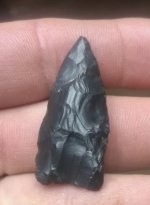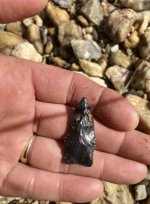Navigation
Install the app
How to install the app on iOS
Follow along with the video below to see how to install our site as a web app on your home screen.
Note: This feature may not be available in some browsers.
More options
You are using an out of date browser. It may not display this or other websites correctly.
You should upgrade or use an alternative browser.
You should upgrade or use an alternative browser.
Fluted Friday
- Thread starter CreekSide
- Start date
Garscale
Bronze Member
Interesting isn't it. It's one of the super deep dug points I dubbed SlothSlayer. About half are actually fluted.Gar, that fluted one that is stemmed what’s the story with that? It’s like your flounder point isn’t it. Flutes and stems aren’t usually associated.
LandSeig
Hero Member
- May 16, 2020
- 508
- 1,353
- Detector(s) used
- Garrett AT Pro, NEL Storm coil
- Primary Interest:
- All Treasure Hunting
How deep down were you and what type is that one?Interesting isn't it. It's one of the super deep dug points I dubbed SlothSlayer. About half are actually fluted.
Garscale
Bronze Member
About 14.5 ft. 1.5 ft into the clay. I found about 40ish of these in various condition along with many tools and flakes.How deep down were you and what type is that one?
Garscale
Bronze Member
Another of them

LandSeig
Hero Member
- May 16, 2020
- 508
- 1,353
- Detector(s) used
- Garrett AT Pro, NEL Storm coil
- Primary Interest:
- All Treasure Hunting
Those are some sweet finds! Was it washed out of a bank or did you dig down that deep? I know a guy that found a point at 15’ while digging a pond at his house, not sure what type, just heard the story. At 15’ down he hit a layer of oak leaves and top soil and was interested in using the dirt for his garden. He found the point in the pile of soil he set aside. We are at 20’ above sea level so it makes you wonder. I figure that the last glacial flood washed a lot of red clay from north of us down to the gulf. I was digging a pond at my place and hit oyster shell at 20’ and we are 50 miles inland from the coast.About 14.5 ft. 1.5 ft into the clay. I found about 40ish of these in various condition along with many tools and flakes.
Garscale
Bronze Member
I was excavating a site. It was about 13ft to the clay. Layered civilization. Clovis right on the clay. I accidentally dug too deep into the clay and saw smears of charcoal. That clay was hard digging but there was a very distinct culture down there and I dug it.Those are some sweet finds! Was it washed out of a bank or did you dig down that deep? I know a guy that found a point at 15’ while digging a pond at his house, not sure what type, just heard the story. At 15’ down he hit a layer of oak leaves and top soil and was interested in using the dirt for his garden. He found the point in the pile of soil he set aside. We are at 20’ above sea level so it makes you wonder. I figure that the last glacial flood washed a lot of red clay from north of us down to the gulf. I was digging a pond at my place and hit oyster shell at 20’ and we are 50 miles inland from the coast.
Garscale
Bronze Member
Here are the points that came out of that clay. Lots of folks here have seen them

LandSeig
Hero Member
- May 16, 2020
- 508
- 1,353
- Detector(s) used
- Garrett AT Pro, NEL Storm coil
- Primary Interest:
- All Treasure Hunting
So those are pre Clovis, would those be considered Daltons?
That is really amazing.
That is really amazing.
Garscale
Bronze Member
Definitely not Dalton.So those are pre Clovis, would those be considered Daltons?
That is really amazing.
Delayed reaction.
Here is a 3 1/4 clovis made of Harrison county flint. Found by Paul Gabbard circa 1950 in a tobacco field in Clark County Kentucky. I obtained this from Paul's 04/16/2010.
Paul E Gabbard August 1, 1941 ~ February 27, 2018 (age 76) lived in Paoli Indiana.

Here is a 3 1/4 clovis made of Harrison county flint. Found by Paul Gabbard circa 1950 in a tobacco field in Clark County Kentucky. I obtained this from Paul's 04/16/2010.
Paul E Gabbard August 1, 1941 ~ February 27, 2018 (age 76) lived in Paoli Indiana.
CreekSide
Silver Member
- Jan 31, 2023
- 3,725
- 12,808
- Thread starter
- #33
Woo Wee that’s a great piece. I’m still looking for a nice fluted Cumberland but I might never find it.Delayed reaction.
Here is a 3 1/4 clovis made of Harrison county flint. Found by Paul Gabbard circa 1950 in a tobacco field in Clark County Kentucky. I obtained this from Paul's 04/16/2010.
Paul E Gabbard August 1, 1941 ~ February 27, 2018 (age 76) lived in Paoli Indiana.
View attachment 2103725
Garscale
Bronze Member
Man that really looks like asphaltum on that base. If it is... that's very important. I have never herd of a Clovis with glues. It is widely accepted that Clovis was pinch hafted with sinue wrapping. Awesome! Both side pics,would be good.Delayed reaction.
Here is a 3 1/4 clovis made of Harrison county flint. Found by Paul Gabbard circa 1950 in a tobacco field in Clark County Kentucky. I obtained this from Paul's 04/16/2010.
Paul E Gabbard August 1, 1941 ~ February 27, 2018 (age 76) lived in Paoli Indiana.
View attachment 2103725
MAMucker
Bronze Member
That’s show stopper! Mammoth age.
Top Member Reactions
-
 3502
3502 -
 1985
1985 -
 1934
1934 -
 1194
1194 -
 1111
1111 -
 1020
1020 -
 871
871 -
 845
845 -
 818
818 -
 796
796 -
 744
744 -
 677
677 -
 579
579 -
 570
570 -
 505
505 -
 450
450 -
 432
432 -
E
415
-
 399
399 -
 390
390
Users who are viewing this thread
Total: 2 (members: 0, guests: 2)










